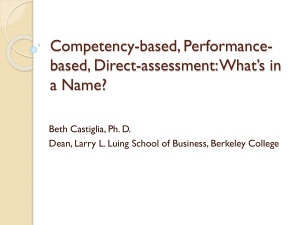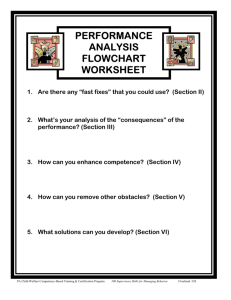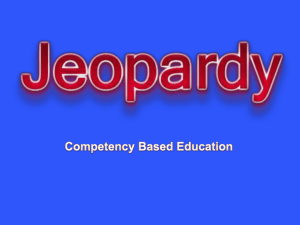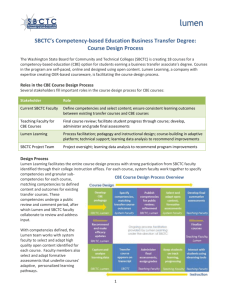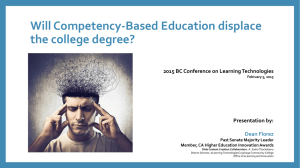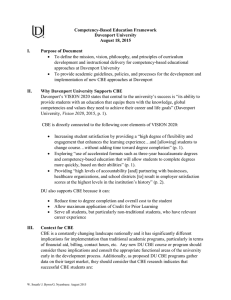Competency-Based Education
advertisement
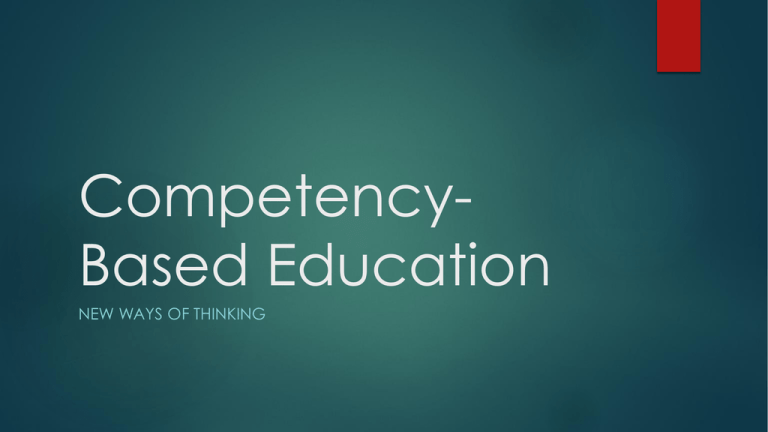
CompetencyBased Education NEW WAYS OF THINKING “Competency-based education programs are an alternative way for learners to gain the skills employers want from employees” Pat Galagan, TD Magazine Upon completion of this session, participants will be able to: Explain the difference between traditional education, competencybased curriculum, and competency-based education. Identify the role of accrediting agencies in CBE. Recognize the basic principles of CBE program development. Articulate and explain the application of CBE as it relates to competency-based curriculum development. Overview Competency and competency-based education Trends in CBE: The role of accrediting agencies CBE programs Competency-based curriculum: Mapping strategy Competency-based barista curriculum Competency and competencybased education Competency, Models, and Modeling Competency • Characteristics that individuals have and use in appropriate, consistent ways in order to achieve desired performance (Dubois & Rothwell , 2004, p. 16). Competency Models • Model that depicts common attributes of top performers in a specific job. Competency Modeling • The process to develop competency models, while competencybased approaches can be strategic and systematic. Competency-based education helps individuals acquire or build the skills to match the characteristics of good or exceptional performers Historical Overview (Ford, 2014) First Generation Second Generation Third Generation •Application of scientific management to work roles •Development of mastery learning models during the 1920s and 1930s •Formative vocational education and training Fourth Generation Fifth Generation Sixth Generation •Moving beyond vocational training to education •Development and transferability of competency or outcome-base curricula •Increase emphasis on direct assessment of competencies rather than instructor-led course Two Educational Paradigms (Sullivan and Downey, 2015) Traditional Carnegie public school model from the early 1800s Instructor-led Text-driven curriculum delivery Time and credit based Delivered to all in same class at same time Failure of a class require a complete repeat Two Educational Paradigms (Sullivan and Downey, 2015) Competency-based Credits based on outcomes that demonstrate academic proficiency Learning driven by set standards demonstrated through application of knowledge and skills Individualized learning tailored to the uniqueness of each student Includes direct instruction, peer instruction, collaboration, self-regulated learning, self-monitoring, in individualized or group learning “Competency-based education is the transformation process from a young person into a life learner in the workforce” Amanda Cecil and B. Krohn 2012 Trends in Competency-Based Education THE ROLE OF ACCREDITING AGENCIES How is CBE different? Clear claims on student learning About what students can do with the knowledge and skills Measurable evidence of competency Recognized by the DoE? DoE sees the benefits and value Testing how Title IV can be delivered in CBE Experimental stage- applying aid via: Direct assessment Credit/clock hours Accrediting Agencies and the CBE Experiment Ensure quality of an institution’s approach to CBE Substantive change evaluation on institution performed by agency Ensure that institutions: Assign credit hours conforming to general practices in higher ed Meet requirement for “regular and substantive interaction” between students and instructors: Access to qualified faculty Interactions built into program design Assessment required How is Assessment Performed? Important in outcomes-focused programs like CBE Faculty does not have to administer/grade everything Faculty feedback effective Exams not substantive interaction Teaching assistants allowed Regular reviews/monitoring needed CBE Programs CHARACTERISTICS AND EXAMPLES CBE Focus Demonstrated mastery of knowledge and skills upon completion of course work clear, measurable learning outcomes Application of knowledge and skills in the real world Academic expectations aligned with industry and market demands Five Principles of CBE Development 1. Degree or certificate Reflects Robust and Valid Competencies 2. 3. Students allowed to learn at a variable, individualized pace Support must be provided on demand Close monitoring of student progress necessary Learning resources are available anytime and are re-usable 4. Validity determined by student and employer feedback Usage statistics and performance analytics should be employed Development and re-development processes are explicit Changes, updates, and revisions follow appropriate paths 5. Designated administrators, instructors, and subject matter experts Assessments are secure and reliable Content is aligned with industry expertise by subject matter experts Typical Structures and Elements Cohort programs with fully online and hybrid courses Certificates; Associates, Bachelor’s Degrees Self-paced with milestones Robust LMS with synchronous instruction capability Canvas, Blackboard, Brightspace, AdobeConnect Object repository and built-in CMS Affordable pricing structures Per Academic Year, Per Course, Per Program Brandman University Course materials accessible 24 hours per day, from any device No print materials or textbooks Self-paced, open enrollment Capability to test out of program requirements Credit for experience and knowledge $5400 per Academic year Programs in arts and sciences, business, education, nursing Certificate and degree programs (Bachelor’s and Master’s Degrees) Southern New Hampshire University: College for America Goals and competencies measured by assessment 20 goals and 120 competencies lead to accredited degree Project based learning incorporating several competencies at once No credit hour or grade points $2500 per year, all inclusive Associate’s Degrees General studies for Business General Studies for Nonclinical Healthcare Bachelor’s Degrees Bachelor of Arts in Communications Bachelor of Arts in healthcare management Competency-Based Curriculum MAPPING STRATEGY Four Phases of Program Creation (Woodhouse and King, 2009) Phase 1: Review update, and synthesize competencies Phase 2: Create a discipline-specific competency matrix Phase 3: Tie assessment practices to competencies Phase 4; Record gaps and overlaps revealed by assessments to improve curriculum CBE Development Identify competencies for course or program Review of body of knowledge, focus groups, research to find competencies Develop a matrix of primary learning categories Group competencies under relevant categories Lays the groundwork for goal structuring and assessment CBE Development cont … Track student learning progression Align competencies with assessments Identify gaps and overlaps in curriculum Address both through updates and revision Assessments Task-oriented assessments based on primary competencies Outcomes should be frequently tested for efficacy Effective assessment should include faculty, industry stakeholders, and administration Refinement of assessments based on institutional review and industry requirements Department of Labor EMBOK Event Design and Production, TISOH Design Lab Competency-Based Barista Curriculum ACTIVITY Instructions… Form groups (nor more than 4 participants per group) and elect a recorder Name your faux-institution Work through the first three phases of the curriculum mapping model to create a course for your institution Phases 1 - 3 Phase 1: Determine and List Competencies Phase 2: Create a barista specific categories of competency (curriculum matrix) Phase 3: Develop assessments for each category ( specific task) CBE Curriculum Share your creation! References Cecil, A. and Krohn, B. (2012). The Process of Developing a Competency-Based Academic Curriculum in Tourism Management. Journal of Teaching in Travel and Tourism, 12, 129-145. Dubois, D. and Rothwell, W. (2004). Competency-Based Human Resource Management. Palo Alto, CA: Davis-Black Publishing. Ford, K. (2014). Competency-Based Education: History, Opportunities, and Challenge. UMUC Center for Innovation in Learning and Student Success.
